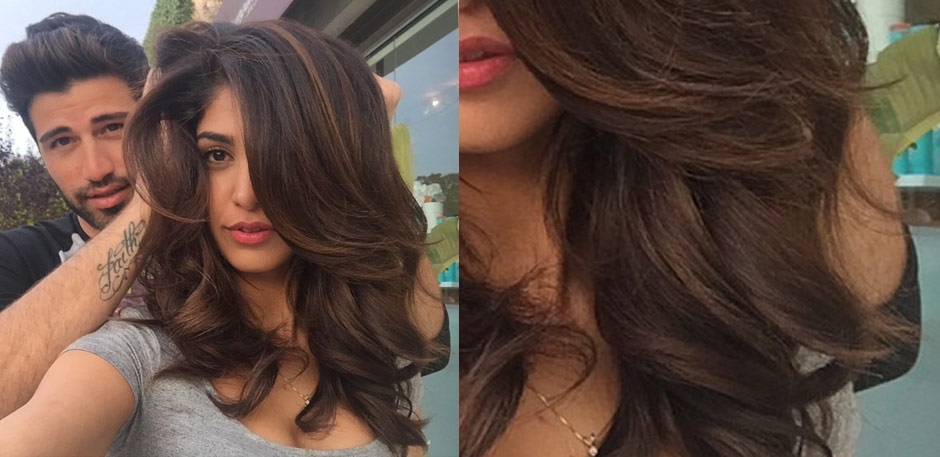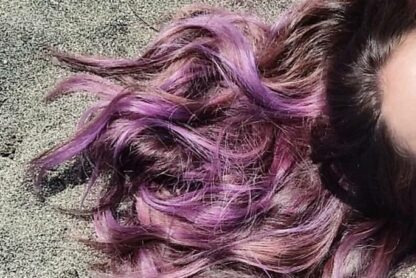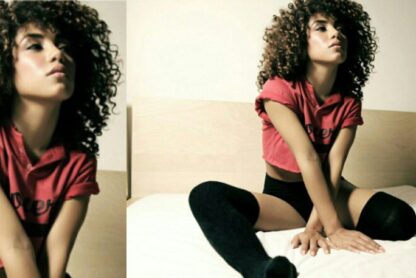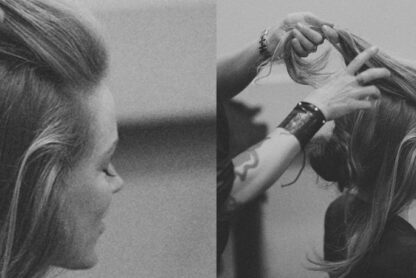To make sure you love your new look, let me give you a quick rundown of some hair color basics. Here are a few terms that can help you understand your stylist when they are explaining what’s possible and how they are processing your hair color.
Permanent, Demi, Semi-Color & Toners – Know the Difference
Permanent Hair Color
This is your strongest type of color and is mainly used to cover gray hair or to take your natural hair color a couple shades lighter. It’s vibrant and rich results can last a while, but permanent hair color is often a lot harsher than other options if it isn’t being used correctly.
But here’s the thing: If you color your hair at home with a professional permanent hair color and you don’t have gray hair? You are creating product build-up that will result in a big color correction if you change your mind and want to go lighter in the future!
In these cases, demi-permanent hair color with the right developer would be your safest bet. An added bonus is that when your natural hair grows in at the root, your new growth is much softer looking.
Demi-Permanent Hair Color
Demi-permanent hair color is what most stylists use on your hair if you don’t have to worry about greys—no more than 10%. Your stylist will make a judgment call what’s best for your hair to achieve your desired results.
The great thing about demi-permanent hair color is that it looks more natural as it washes out and your new growth comes in. This is a lot more appealing to most clients than the visible growth caused by permanent color.
Demi-permanent hair color is supposed to last 4-6 weeks, though in many cases it lasts even longer. Most clients come in and only touch up their roots and only occasionally refresh the color all over.
Semi-Permanent Hair Color
Typically semi-permanent color washes out in a couple of shampoos, so it’s most popular with anyone who likes to change their color frequently. Sometimes it can last for a couple weeks, but because it only coats the first few layers of your hair, the color washes out with every time you shampoo.
When semi-permanent hair color starts to fade into a lighter version of what it was, it generally doesn’t look very pretty. This kind of color is fun to try without too much commitment! Just keep in mind that, if it doesn’t rinse out all the way and you want it changed, you might need a color correction service to start fresh. And those can get pricey if for example your semi color was a vivid color like green or blue.
Toners
Toners are probably the #1 thing clients ask me about since most clients don’t understand why the extra step is necessary to get great color.
We use toners over hair that has been lightened or, as you might know it, bleached. Toners are applied to change the tone of your hair or to remove unwanted brassy tones. So even if your foiled hair turned out beautiful, we might tone it because you wanted a different tone of blonde, caramel, lavender, blue, red, you name it!
A stylist can call a demi-permanent color a toner as well. Basically, toning is a step we add to make sure we get the look you want.
Highlift Hair Color
Highlift hair color is used to get your hair color lighter without using lightener or bleach. This isn’t ideal in every case because it is used on natural hair and the results are usually not as vibrant.
Your stylist may choose to use on you if they feel it will work best, but I would say this is a more complicated color process to master because the results are not as predictable. I normally use it on someone who has almost all gray hair to color their hair blonde, or if someone is already naturally blonde then I will use the highlift color to brighten them up a couple shades. We also can use highlift color to tone pre lightened hair (bleached hair) to lift out any additional tones we don’t want to see.
Lightener (Also Known as Hair Bleach)
Lightener is used to lighten your hair or to remove old hair color. For example, if you have dark brown hair color on your hair and you want to be three shades lighter, we can’t just apply a lighter hair color on your hair, because color alone doesn’t lighten—only lightener can. You would first get your hair lightened or stripped, then the lighter shade would be applied.
You know what else? When professionally applied, lightener isn’t as scary as you might think. My hair is lightened, and it looks healthier than some clients who have all natural hair. It’s all about how someone is coloring your hair and how well you take care of your hair on a day-to-day basis. Ask your stylist about adding Olaplex to your hair service if your hair is very damaged from lightening it over and over.
The more we know…
Hair color is a lot more technical than people believe it to be and being informed about why your hair color works the way it does is something we should spend the time on.
I can use the same color on three different people, and it will look different on all of them if their color is different to start out with! While your stylist can create a mix of colors that will get you as close as possible to your inspiration picture or the description of what you want to be done, it’s important to be honest with them about what color you’ve already used, as well as listen up when they break down realistic expectations.
Finally, know that we appreciate everyone who is patient and trusts the process. Ask your stylist anything you don’t understand and they will gladly explain it to you.
Thank you for reading and please ask me questions below or if you are a stylist, please feel free to add anything you want your clients to understand as well.
Image credit: Alen M









